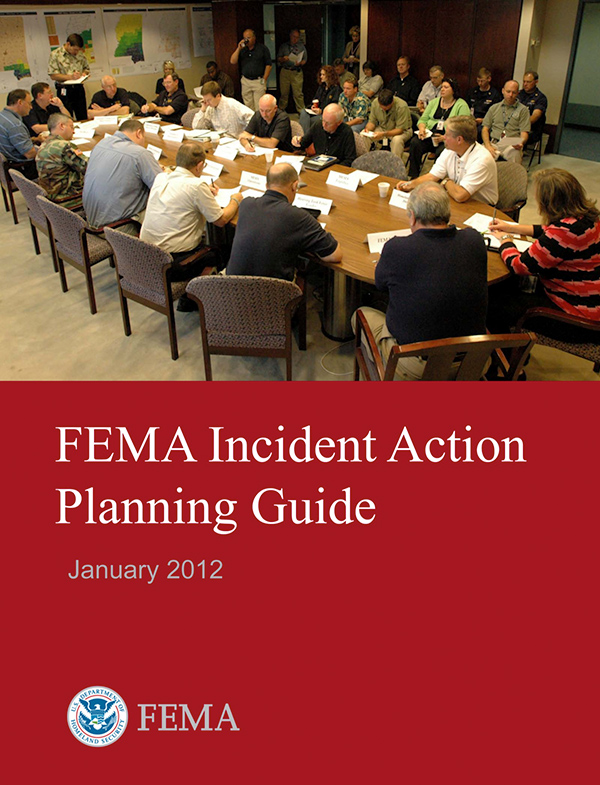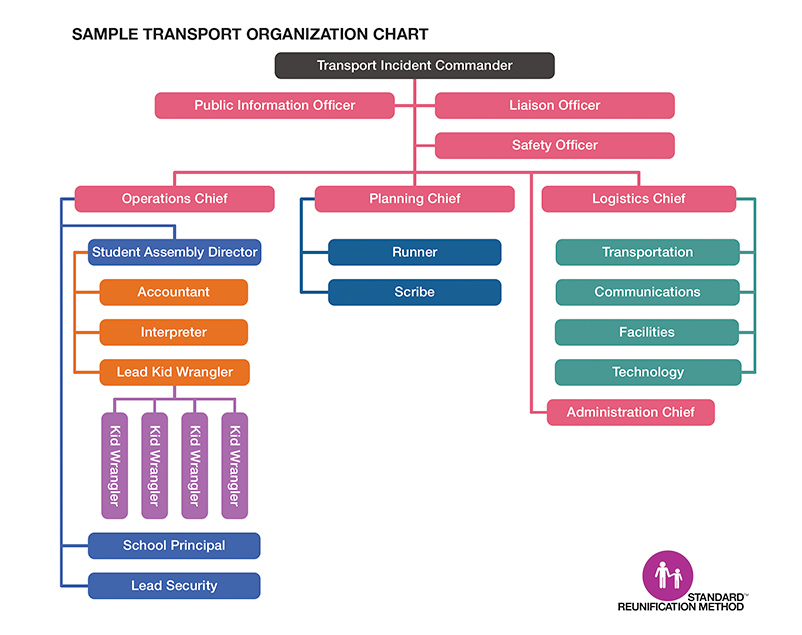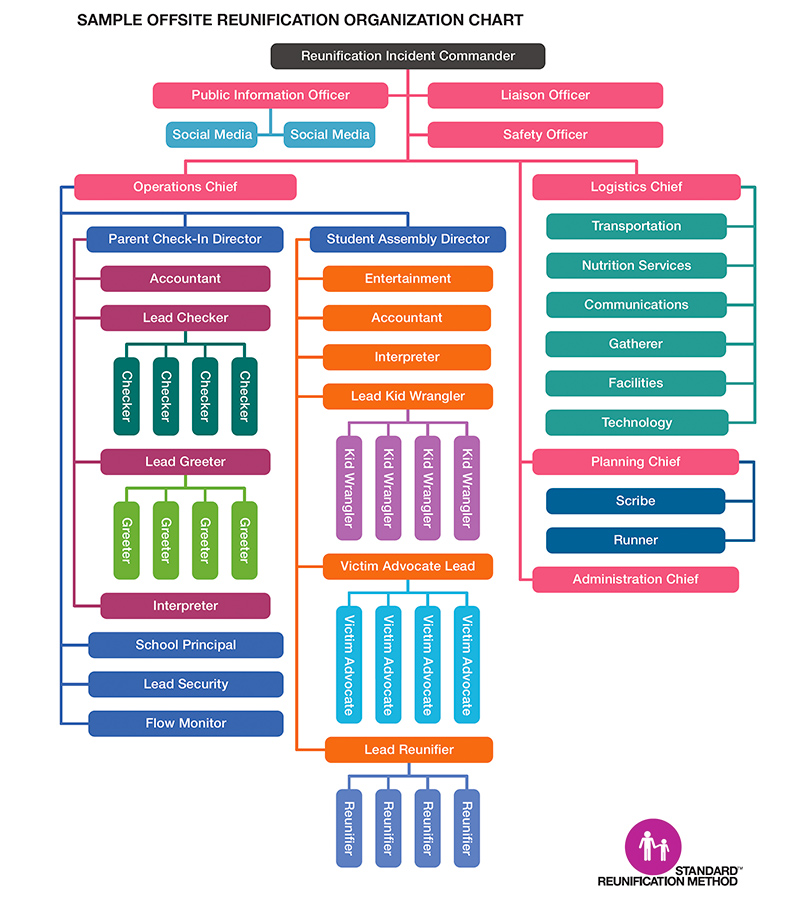TxSSC
K-12 Standard Reunification Method Toolkit
1.1 Incident Command System

Incident Command System (ICS)
Whether it is a man-made or natural crisis, or an act of violence in the school, law enforcement, fire and medical teams will be involved in the school or district’s reunification process. Learning to understand and speak a common language as well as being familiar with their procedures is imperative to a successful outcome. With that in mind, district and school safety teams must understand and use the Incident Command System.
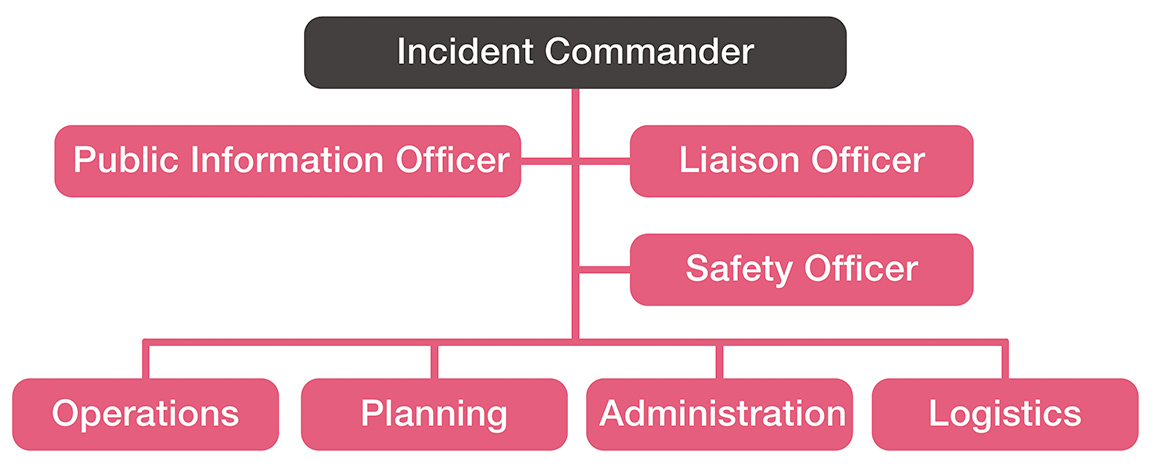
Not So Weird Advice
At first blush, this bit of advice may sound weird to educators: “Check out FEMA. Go to training.fema.gov and complete the online training for IS-100 SCa Introduction to Incident Management for Schools.” The course takes about an hour and a half to complete and introduces some basic emergency response principles in the context of school safety.
Here’s why this advice isn’t as weird as it sounds. Every first responder agency that partners with schools uses “Incident Command” during a crisis. The “Incident Command System” (ICS) is a response method that determines the role of everyone responding to a crisis and defines a shared vocabulary and shared expectations of behavior.
District and school safety teams need this shared vocabulary when interacting with first responders during a crisis. Equally important is that, when meeting with first responders, having the concepts and vocabulary of Incident Command removes some of the language barriers. It also shows a commitment to success that departments and agencies will appreciate.
Priority, Objective, Strategy, Tactic
A valuable FEMA resource is the Incident Action Planning Guide, and it’s a good start in understanding how first responders manage an incident.
From a school or district perspective, it’s important to understand that the incident commander has an expectation that to be useful during the event, the school or district personnel need to have some experience with incident command.
If the school or district personnel don’t exhibit any knowledge of the process, their input may be marginalized.
Articulate Your P.O.S.T.
The first step in incident management is defining the priorities, objectives, strategies and tactics that will be used during the event. While every incident will be unique, there are considerations that can be addressed in advance.
Priorities:
- Student and staff safety and well-being.
- Student and staff whereabouts and condition.
- Starting the recovery process.
Objectives:
- Every student has been accounted for.
- Every staff member has been accounted for.
- Every student still in the school’s control is reunited with their parent or guardian.
Strategies:
- The Standard Reunification Method
Tactics:
- Tactics will vary based on the event and the environment, but look at the typical lifecycles on page 16 for a jumpstart.
Joint Information Center and The Social Media Team
An essential role in the JIC is the Social Media Team. The team should have a couple of people monitoring social media outlets, and when directed by the lead Public Information Officer, releasing any information to social media outlets. School systems are required to employ or appoint a public information officer who must obtain certification from the Texas Division of Emergency Management within one year of hiring or appointment. Continuing education is required annually. Compliance records of continuing education shall be provided to TDEM.
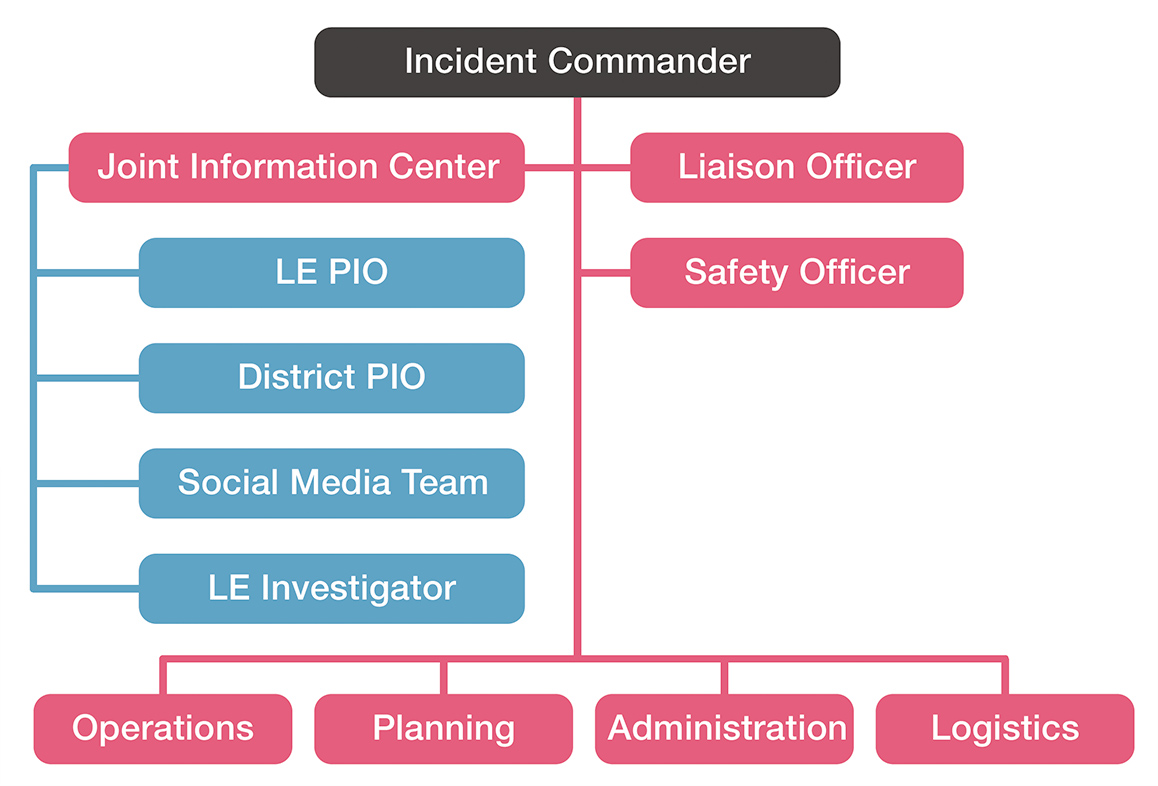
If possible, Public Information Officers (PIO) from all of the responding departments or agencies and the district PIO should be physically together with the Social Media Team. If it’s a criminal event, there is a growing trend for law enforcement to assign a detective or investigator to the JIC to monitor social media for evidentiary information.
It is important to recognize that if students have been transported to a separate reunification site, a second command structure will be set up there as well. It may be labeled as a division under Unified Command and will need resources from first responders, but a command structure will need to be established to manage the reunification process, separate from the initial incident.
Two Teams: Transport and Reunification
With an offsite reunification, the district reunification team will deploy to the reunification site. Other responsibilities need to be managed at the impacted school. Regardless of criminal activity, law enforcement resources will be required.
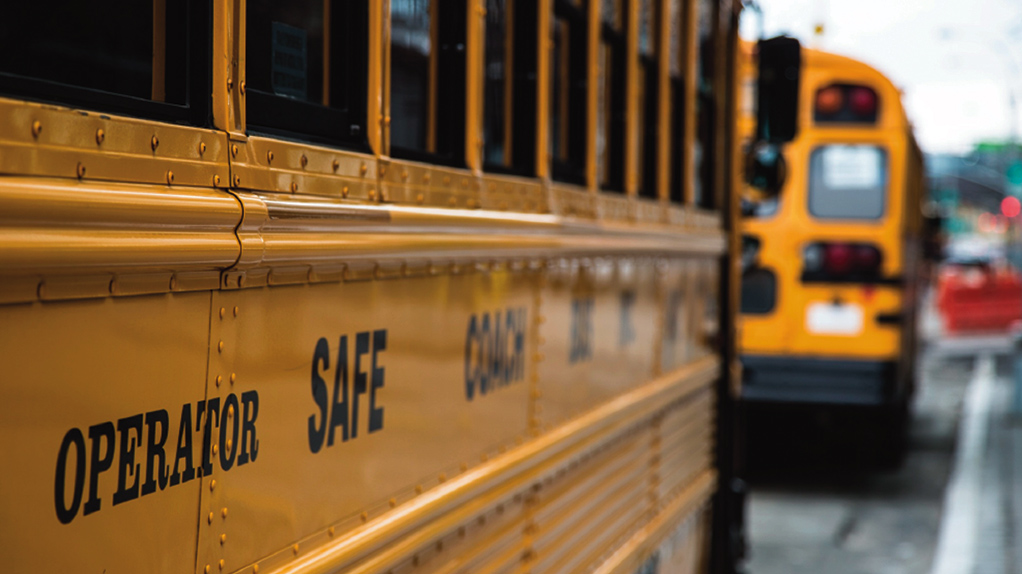
There are two teams the district must field for an offsite reunification. The team at the impacted school facilitates transport and initiates accountability processing.
The reunification team deploys to the reunification site for staging and, ultimately, student/parent reunification and return transportation of teachers and staff.
Impacted School: Transport Team
The team at the impacted school has these priorities:
- Assemble a master student roster, teacher roster and guest roster
- Identify and notify reunification site
- Provide safe transport of students and staff to reunification site
- If there are injuries, additional district personnel assign to the receiving care facilities
Law Enforcement Support
At the impacted site law enforcement support may be necessary. Some assignments may include:
- Traffic Control
- Crowd Control
- ID Verification
- Perimeter Control
- Security
- Liaison
In the event of criminal activity, LE will typically take the lead in Unified Command.
At the secure assembly area, law enforcement may search students and staff. One important consideration for law enforcement is, if possible, perform the search of students out of sight of the media.
Transportation Director
Whether the district runs its own buses or service is contracted out, the Transportation Director should be involved in all planning, drilling and training for reunification.
Transport Operational Roles and Duties
The following outlines the roles and duties of the Transportation Team. For detailed tasks see the Job Action Sheets.
Transport Incident Commander - Coordinate Priorities, Objectives, Strategies and Tactics for an accountable, easy, reunification of students with parents.
Public Information Officer - Communicate with parents and press, if appropriate. Coordinate use of mass call or text messages.
Social Media Team - Monitor social media. Use your district’s communication tools you have for social media.
Safety Officer - Observe site and remedy safety concerns.
Liaison Officer - Communicate with Fire, Medical or Law Enforcement.
Operations Chief - Establish and manage operational staff.
Planning Chief - Establish and manage planning staff.
Finance/Administration Chief - Establish and manage administrative staff.
Logistics Chief - Establish and manage logistical staff.
Student Assembly Director - Establish and manage the Student Assembly Area.
Leads - For span of control, some roles may need leads.
Victim Advocates/Counselors - Standby unless needed.
Kid Wranglers - Teachers and Staff who arrive with students remain in the Student Assembly Area to manage students. Additional people may be assigned to this task.
Scribe - Document events. A yellow pad is sufficient.
Runner - Assist Incident Command if needed.
Transportation - Direct transportation needs.
Communications - Facilitate radio and other communication needs.
Facilities - Coordinate any physical plant needs.
School Principal - High priority for transport to the reunification site. Be present at Parent reunification site.
Superintendent - Verify reunification site and notification.
Teachers: Stay With Your Students
Interviews with safety directors directly impacted by crisis reveal a common thread. Often teachers will group together in the immediate aftermath, or assume their job is done when police arrive on scene. It’s important to emphasize that teachers should remain with their students and aren’t done until all of the students have been reunited with their families. Certainly, exceptions are appropriate for teachers who are also parents of impacted students.
(Click above image to download Sample Oganization Chart.)
The District Reunification Team
Most often the Reunification Team is populated by district personnel. There are several reasons for this:
- Training can be more readily coordinated.
- Experienced teams are more proficient.
- School based teams may initially be unavailable.
Smaller districts may recruit from various schools’ administrators in order to populate the team. Extremely small districts may recruit volunteers from the community to staff the Reunification Team. A good rule of thumb for team size is one per hundred students, plus another five members.
Once school staff are at the reunification site, there are roles that the school staff will assume. It’s important to train school staff in their role during a reunification.
Who Are Victim Advocates?
Many law enforcement agencies, district attorneys, and prosecutors have victim advocates on staff and a cadre of volunteers. They often deploy when there is a crisis. Very often they are trained in Psychological First Aid and can be helpful with crisis counseling, if needed, during a reunification. Recruit and train these community partners.
Including First Responders
It is absolutely imperative that as the reunification plan is developed, first responders are brought into the process. Meeting with command staff, including PIOs, both law enforcement and Fire/EMS will generate two outcomes. First, they will look at your plan from their perspective. Second, they have suggestions you might not have thought of.
During a Standard Reunification Method workshop, conducted by The Foundation, a fire chief requested the training for every fire station in his city. When questioned why, he replied, “We are going to be on scene. If we’re not actively engaged in fire or EMS, we can help with the reunification process.”
Law Enforcement Support
At the reunification site law enforcement support may be necessary. Some assignments may include:
- Traffic Control
- Crowd Control
- ID Verification
- Perimeter Control
- Security
- Liaison
(Click above image to download Sample Oganization Chart.)
Operational Roles and Duties
The following outlines the roles and duties of the Reunification Team. For detailed tasks see the Job Action Sheets.
Reunification Incident Commander - Coordinate Priorities, Objectives, Strategies and Tactics for an accountable, easy reunification of students with parents.
Public Information Officer - Communicate with parents and press, if appropriate. Coordinate use of mass call or text messages.
Social Media Team - Monitor social media. Use your district’s communication tools you have for social media.
Safety Officer - Observe site and remedy safety concerns.
Liaison Officer - Communicate with Fire, Medical or Law Enforcement.
Operations Chief - Establish and manage operational staff.
Planning Chief - Establish and manage planning staff.
Finance/Administration Chief - Establish and manage administrative staff.
Logistics Chief - Establish and manage logistical staff.
Parent Check-in Director - Establish and manage the check-in process.
Student Assembly Director - Establish and manage the Student Assembly Area.
Leads - For span of control, some roles may need leads.
Greeters - Help coordinate the parent lines. Tell parents about the process. Help verify parents without ID.
Checkers - Verify ID and possibly custody rights of parents or guardians. Direct parents to Reunification Area.
Reunifier - Take bottom of Reunification Card to Assembly Area, locate student and bring to Reunification Area. Ask student, “Are you okay going home with this person?” flow Monitor Observe and remedy process hiccups.
Victim Advocates/Counselors - Standby unless needed.
Kid Wranglers - Teachers and Staff who arrive with students remain in the Student Assembly Area to manage students. Additional people may be assigned to this task.
Entertainment Director - At the elementary level, deploying a projector and screen can reduce student stress. With middle and high school students, consider turning on a television and tuning to local news if appropriate.
Scribe - Document events. A yellow pad is sufficient.
Runner - Assist Incident Command if needed.
Transportation - Directs transportation needs.
Nutrition Services - Provide snacks and water.
